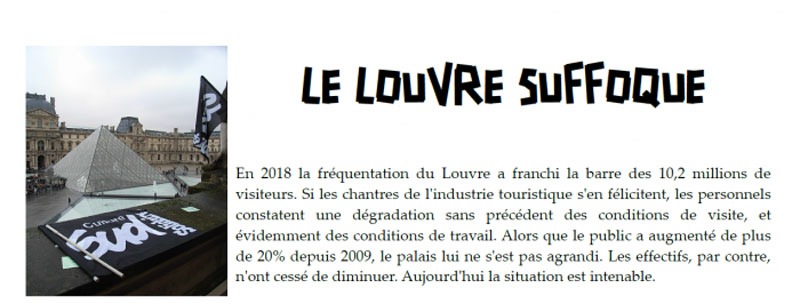
May 28, 2019; Hyperallergic
What is the function of a museum so famous that its building is as well known as some of the works inside? The Louvre Museum in Paris is undeniably French, and indisputably a world icon. How does it serve both populations at once?
This problem wasn’t critical until recently, when the number of annual visitors ballooned over 10 million, more than the population of 30 small countries combined. Even spread over the museum’s 15 acres of gallery space, that’s too many, say the museum’s reception and security staff. And so, they went on strike. (Naturellement.)
On Monday, May 27th, the Louvre closed its doors to visitors. It opened again on Wednesday (it’s always closed Tuesdays), but the website now specifies entry is only guaranteed to those who buy tickets in advance online.
The striking staff published a statement in Sud Culture Solidaires, explaining that they could no longer safely manage the work of keeping both visitors and collections safe. Visitors confront them, angry about the difficulty of moving around the galleries; security cannot monitor suspect objects, and they have no adequate evacuation measures in case of an emergency. (Specifically, they “cannot distinguish suspect objects from our own feet in the crowds.”) They are worried that, as prime tourist season approaches, it will become impossible to walk in rooms such as the one that houses the Mona Lisa, where crowds have reached truly astonishing levels.
Staff said they regularly heard comments such as, “The conditions of one’s visit are deplorable….It’s sad to think the objectives of the museum have become purely mercantile.”
Sign up for our free newsletters
Subscribe to NPQ's newsletters to have our top stories delivered directly to your inbox.
By signing up, you agree to our privacy policy and terms of use, and to receive messages from NPQ and our partners.
In addition to their more immediate concerns about work conditions and safety, the strikers agreed with this larger concern. Under the section of their statement entitled “Right Now!” staff declared:
Beyond these immediate necessities, the Louvre must engage in profound reflection to redefine the contours of our mission. Cease the mass tourism, halt the transformation into Disneyland culture, and offer a quality cultural experience to all; this is the stake of these decisions!
The Louvre’s quandary—the dangers its popularity poses to the integrity of the place—is being faced by other sites worldwide. But the Louvre isn’t just a site, it’s an active cultural institution, and the debate about its mission is complicated.
Arguments can be made on both sides. The museum bills itself as a world destination; its website describes itself as “a universal museum. It opened an affiliated Louvre Abu Dhabi in 2017. It houses artifacts from all over the world, including the Code of Hammurabi, the Winged Victory of Samothrace, friezes from Syria, Egyptian statuary over 3,000 years old, and more. (The future residence of some of these objects may be up for debate after President Macron’s commitment to repatriate cultural icons late last year.)
But the building (or some part of it) has stood in the center of Paris for nearly 900 years. The original tower, which is still visible in the lower floors, was built by the same king who chartered the University of Paris and went on the Crusades with Richard the Lionheart. The Louvre was opened as a museum during the French Revolution in 1793, when the Tuileries Palace (as it was then known) and the royal collections therein were declared national property. The Assembly that governed Paris asserted that it would be “a place for bringing together monuments of all the sciences and arts” to “preserve the national memory.” Just recently, the museum partnered with Airbnb to offer $34 after-hours private tours, which were advertised very quietly and only in French, to encourage city residents to visit again.
Louvre staff had a general meeting on Wednesday to review responses from the museum and ministry management, but the museum as an institution has declined to comment on the problem. (Imagine crafting that statement.) According to The Local, proposed solutions “included the implementation of a system of mandatory reservations, the hiring of an additional 30 staff members and spreading out the calendar of numerous construction and renovation projects, which employees say increase tension and crowding in the museum.” Further information has not been forthcoming.—Erin Rubin












